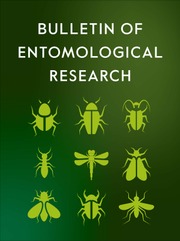No CrossRef data available.
Article contents
Trait-based explanation of circadian flight rhythms in bark and ambrosia beetles (Scolytinae)
Published online by Cambridge University Press: 25 August 2025
Abstract
Understanding the circadian rhythms of bark and ambrosia beetles (Scolytinae) is crucial for assessing their dispersal strategies, trophic specialisation, and microhabitat preferences. This study investigated circadian rhythms in Scolytinae communities using flight interception traps in an oak forest in the southern part of Czechia. Ordination biplot revealed a flight activity gradient, with nocturnal dispersers distinct from diurnal species. Species richness gradually decreased from the 20:00–24:00 interval through to the 12:00–16:00 interval, with the most notable decline observed between the 08:00–12:00 and 12:00–16:00 intervals. A combination of fourth-corner and partial canonical correspondence analyses identified tribal affiliation, trophic specialisation, and microhabitat preference as key drivers of flight structuring. Members of the tribe Xyleborini showed negative association to the 16:00–20:00 interval. Xylomycetophagous species, such as Xyleborinus saxesenii exhibited multimodal activity peaks, with increased flight from nighttime to early morning. In contrast, species that feed in the phloem such as Scolytus intricatus showed no significant association with any specific time interval. Several species that utilise stumps as potential breeding substrates showed significantly reduced flight activity during the crepuscular period, which supports the hypothesis that microhabitat preference contributes to diel periodicity. Our findings show the complex interplay between abiotic and biotic factors in shaping circadian flight periodicity, which leads to distinct flight activity patterns between Scolytini bark and Xyleborini ambrosia beetles. These results emphasise the ecological significance of maintaining heterogeneous forest structures that provide a balance of shaded and sun-exposed deadwood habitats to support diverse assemblages.
Information
- Type
- Research Paper
- Information
- Copyright
- © The Author(s), 2025. Published by Cambridge University Press.


